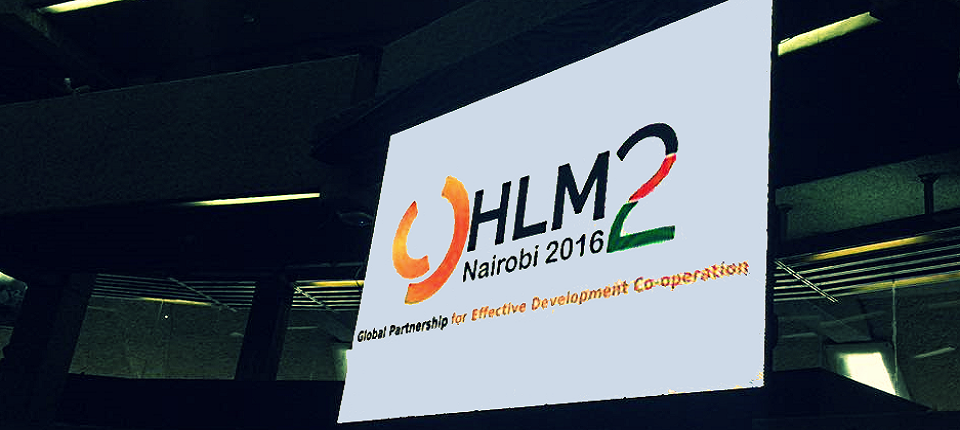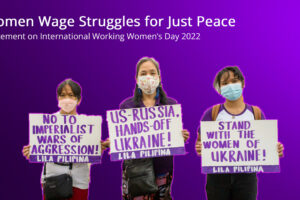[[{“type”:”media”,”view_mode”:”media_large”,”fid”:”1641″,”attributes”:{“alt”:””,”class”:”media-image”,”height”:”413″,”style”:”width: 350px; height: 301px; margin: 5px; float: right;”,”typeof”:”foaf:Image”,”width”:”480″}}]]The outcome document of the Second High-Level Meeting (HLM2) in Nairobi of the Global Partnership for Effective Development Cooperation (GPEDC), despite some significant drawbacks, can serve as a stepping-stone from which it is possible to effect substantive change in global development processes. In order to realize this change, however, civil society organizations (CSOs) will have to act aggressively and decisively to resist powerful corporate interests that aim to subordinate people-oriented development to the private benefit of a small minority.
This will not be easy given the difficult environment for CSOs that has escalated hand-in-hand with global militarism. In many countries, governments curtail civil liberties and impose tight constraints on CSOs under the guise of “anti-terrorism” campaigns that have often targeted organizations working with marginalized communities.
It is a definite accomplishment that, as a result of civil society pressure, the Nairobi outcome document includes recognition of the shrinking space available to CSOs pursuing development objectives as “part of our shared reality” and asserts that this, among other things, “must be addressed through partnership.”[1]
Related to this, the document recognizes “the essential role of civil society as an independent partner in its own right in effective development cooperation, poverty reduction, tackling inequality and progress toward the SDGs and the 2030 Agenda.” [2]
Yet some sections of the document are striking for their failure to recognize past lessons regarding the consequences of introducing the profit incentive as a guiding axiom of development practice. Problematically, for example, the HLM2 outcome document frames “the challenge to leave no-one behind as an opportunity for private capital to increase prosperity and raise public revenue, drive down the cost of access to goods and services, and promote sustained, inclusive sustainable economic growth.”
There is little evidence showing that private capital in itself leads to greater prosperity. There is also no evidence pointing to an easy connection between private capital and increased public revenue. On the contrary, there is significant evidence demonstrating that business sector involvement in social goods and services (e.g., hospitals, water, transportation) tends to result in diminished accessibility. This contributes to unequal development. The “opportunity for private capital” accordingly poses an enormous threat to the ambition to leave no one behind.
The position in the outcome, moreover, runs the risk of empowering efforts to divert official development assistance (ODA) away from its proper use as a resource for addressing poverty and inequality, and for catalyzing democratic ownership. This is apparent when the Outcome states that “an important use of international public finance, including ODA, is to catalyze additional resource mobilization from other sources, public and private [. . .]. It can also be used to unlock additional finance through blended or pooled financing and risk mitigation, notably for infrastructure and other investments that support private sector development.”[3]
ODA used for leveraging such as “blended or pooled financing and risk mitigation” has not at all been established to be additional from a development standpoint. Leveraging activities are, furthermore, mainly undertaken by development finance institutions (DFIs). These institutions have mandates generally conflicting with the development effectiveness principles and instead promote donor-country business interests.[4]
It is even more alarming that, rather than fully respecting the ability of developing countries to create their own development frameworks, the Outcome adds constraints in the form of commitments for “countries receiving support” to promote the use of public-private partnerships (PPPs).[5]
PPPs privilege dominant business actors (as few companies generally even have the capacity to apply for such partnerships),[6] while limiting democratic ownership and accountability to communities, and have yielded negative impacts (including mass displacement) that have engendered significant protests.[7]
These aspects of the Outcome stand in stark contrast to the commitments to “mutual learning, mutual benefit and mutual accountability.” In a development effectiveness framework, mutual learning should entail recognizing the consequences that financing modalities such as PPPs have so far produced. Mutual benefit should be understood in the context of a clear focus to eradicating poverty and inequality, i.e., leaving no one behind. Mutual accountability should empower the supposed beneficiaries of development, the poor and the marginalized, in claiming their right to development.
The space provided by the GPEDC represents an important opportunity. In order to use this to expand the focus of development cooperation on people- rather than profit-oriented development programs, CSOs, in their engagement with the process, will have to resist corporate interests every step of the way.
[1] GPEDC (2016), Nairobi Outcome Document, §5, Second High-Level Meeting of the Global Partnership for Effective Development Cooperation.
[2]Ibid., §13.
[3] Ibid., §23.
[4] CPDE-TUDCN (2016), ‘The Development Effectiveness of Supporting the Private Sector with ODA Funds’, Research Paper, Brussels: ITUC.
[5] GPEDC (2016), ibid., §63.
[6] Maria José Romero (2015), What Lies Beneath?: A Critical Assessment of PPPs and their Impact on Sustainable Development, Brussels: Eurodad.
[7] CJ Mercado (2016), Special Release: A Primer on PPPs in Food Agriculture, Quezon City, Philippines: People’s Coalition on Food Sovereignty.

![[INFOGRAPHIC] Debt burdens and the IMF, World Bank](https://iboninternational.org/wp-content/uploads/2021/04/DEBT-BURDENS-AND-THE-IMF-WBG-FULL-300x200.png)

